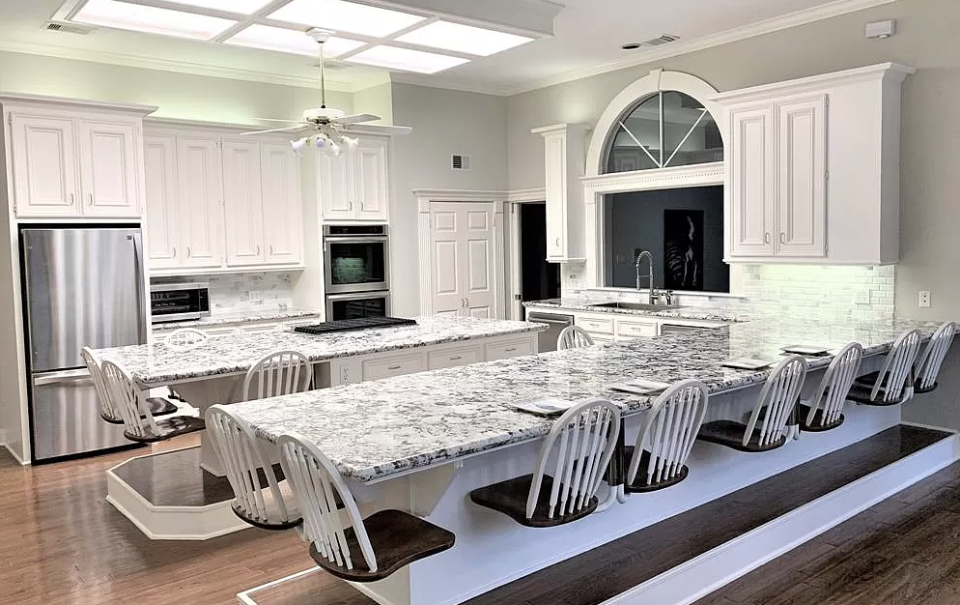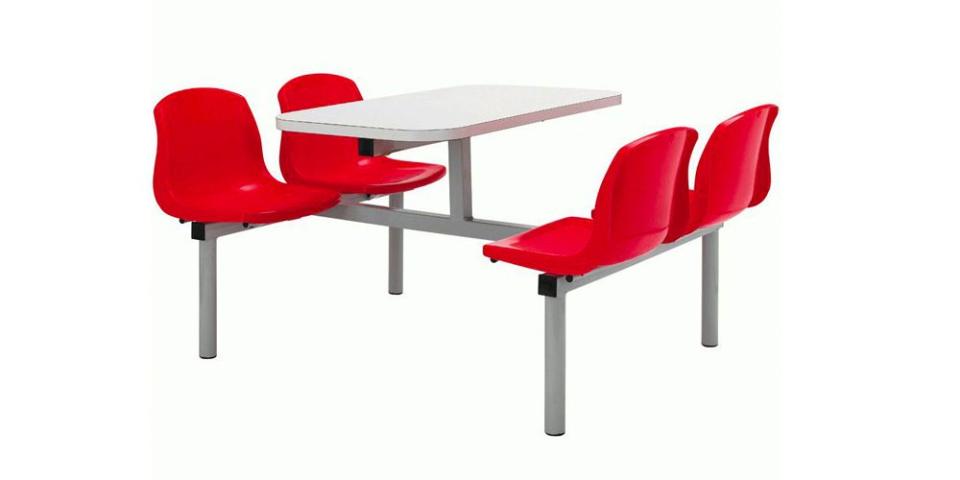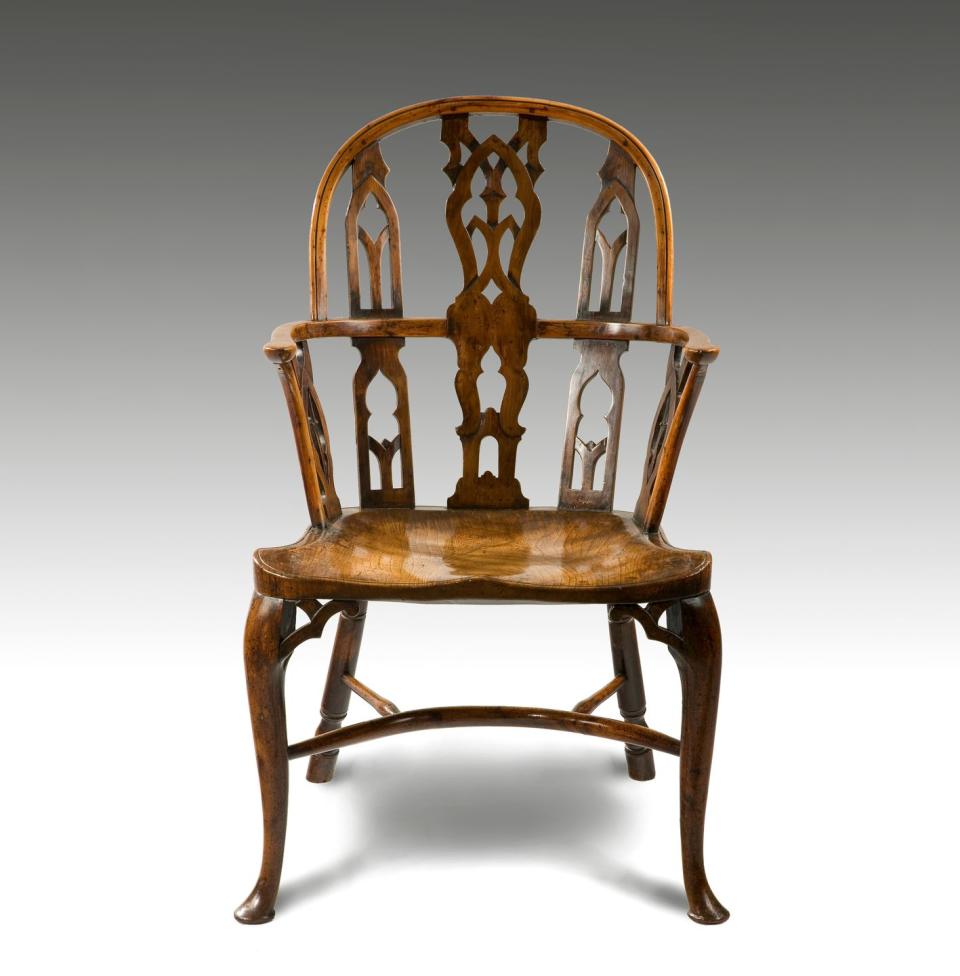People Are Scratching Their Heads Over These Viral Kitchen Chairs

A real estate listing for a mansion in Texas has gone viral because of a photo that shows 26 floating chairs attached to counters in the kitchen.
That is too many chairs.
Does the fixed swivel chair serve a purpose? Any purpose at all? Join us and find out.
Let’s get this out of the way: Twenty-six chairs is just too many chairs to have in your kitchen, even if those chairs are the most aesthetically mind-blowing and posteriorly pleasing chairs on the planet.
The chairs in this posh suburban Texas McMansion—the listing for which went viral this week—are decidedly not that.
The $995,000 chateau in question sits on a cul-de-sac in Spring, Texas, outside Houston, and has been on the market for 406 days, according to Zillow. Inside the estate you’ll find the standard swanky stuff: The spiral staircase. The grand piano. The recording studio. The basketball court. But none of those lavish amenities have drawn the ire of the internet.
Credit architecture critic Kate Wagner, who writes the blog McMansion Hell, for bringing the listing’s singular centerpiece to the world’s attention. The granite counters in the kitchen, which seemingly serve as hybrid spaces for eating, cooking, and working, bizarrely come with attached floating chairs under them—the kind you might find in a fast-food joint or, say, on a spaceship.


Even weirder: The legless chairs appear to not leave much, if any, room for your knees, should you choose to sit in one. (But where else would you sit? Reader, that’s a good question.) Weirder still, of course, is the sheer number of these things assembled in one room. Commenters have counted 26, but there very well might be dozens—maybe even hundreds—more lurking just out of frame.
KNEES?!?! pic.twitter.com/Y5eKRjrzoN
— The Wicked Witch (@BitchWithA_W) February 21, 2020
did...did a roomba design this
— ganonline (@gerudoku) February 21, 2020
The easy thing to do here would be to keep piling on, but that’s what Twitter is for. Instead, we wanted to find out why such chairs exist—and, perhaps more crucially, why they’ve elicited such a visceral reaction from the rest of us sitting here in our extremely normal chairs.
So. About Those Chairs.
Turns out the chairs aren’t native to pricey Southern palaces, but rather, the kind of restaurants where you can grab a 10-piece nugget and medium fry combo for a few bucks in between errands.

“They’ve been standard for years in the low-end fast food world,” says Robert Ferguson, a Senior Lecturer in the School of Architecture at the University of Minnesota. You’ve certainly seen the seats at McDonald’s and Burger King—requests for comment to both chains sadly went unanswered—and shopping mall food courts for two precise reasons: they’re intentionally uncomfortable, so customers don’t stay in them for very long (leading to faster table turnover), and you don’t have to move them to mop the floor, Ferguson says.
You might also see the chairs attached to fixed tables in college classrooms. Ferguson’s students at Minnesota, for example, hate them. “Obviously, table turnover isn’t the issue there, though time saving for the custodial staff might well be,” he says. “That’s one thing that justifies the additional upfront expense of, for example, those restroom stall partitions that are suspended from the walls or ceiling.”
In a fancy residential kitchen, the expense could be part of the attraction, says Ferguson. But attention-grabbing furniture doesn’t mean anything if it doesn’t serve a function—and that’s where things don’t, uh, sit right with Galen Cranz, a professor of the graduate school in architecture at the University of California, Berkeley.
Cranz wrote the book on chairs—literally. In 1998, she penned The Chair: Rethinking Culture, Body, and Design, so she’s as good of an authority on the topic as anyone. And she doesn’t like what she sees. Not one sit.
“I’m very disappointed to see they’re doing something eye-catching without any real rethinking of the problem of seating,” Cranz says. She suspects the chairs have gone viral because they negatively tap into the three main pillars of how we traditionally think about taste: aesthetics, meaning, and utility.
A Matter of Taste
We’ll hit aesthetics first. These chairs have some of the stylistic qualities of a classic Windsor (seen below), which means both the legs and back are inserted into the seat pan, or the flat surface area you actually sit on. The distinction: Our chairs are only the top half of a Windsor.
The floating aspect is certainly untraditional—“it’s daring and space age-y,” says Cranz—but “the contradiction is the untraditional look of floating compared with a traditional Windsor motif that’s about craft, construction, and being on the ground,” she says. “I suspect that’s what shocks people.”

Now let’s move to meaning. Chairs usually symbolize individuality, Cranz says, while sofas and benches are designed to be used by multiple people at the same time. It looks like the strange kitchen chairs are linked with each other, so they must be used in exactly the same way—i.e., if one person moves, the other person has to follow suit. “So there might be some underlying social irritation if there’s not enough individuality here,” says Cranz. “We expect that chairs allow us to be autonomous individuals.”
Finally, there’s arguably the most important facet of taste of all: utility. And these chairs—most chairs, really—aren’t fundamentally useful when it comes to helping our bodies.
The reason a chair’s seat pan is usually tipped back is because in your typical 90-degree angle seated posture, you naturally slide forward. As you recline on the chair back, you push your pelvis so far forward to the edge of the chair that you end up in a rounded position. This is absolute hell on your spine.
Designers decided, then, to try to tip the seat up in the front, so that you couldn’t slide forward so much, Cranz says. The problem? If you’re short, this creates pressure under your thigh, reduces blood flow, and most importantly, rounds your spine. So chair designers still haven’t come up with a satisfying solution for the masses—certainly not our lovably demented floating kitchen chair, which is tipped backward and thus bad for your back.
Ultimately, we’re better off ditching chairs altogether and sitting on bar stools, says Cranz. “That way your thighs have an oblique relation to your torso,” she says, “which allows your lumbar curve to stay in place and your spine to retain an elongated ‘S’ shape. It’s just structurally much better for us.”
Or if you’d prefer to stand for the majority of your day—after all, prolonged sitting has been linked to increased risks for cancer, diabetes, heart disease, obesity, and more—consider buying a stand-up desk. Better yet? Just build one yourself.
Until the world converts to stools and standing, however, we’ll keep finding increasingly wild chairs in which to plop our butts. And we’ll keep investigating why.
You Might Also Like


